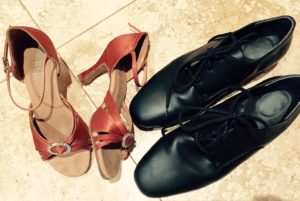The Basic Rules of Tango (and marriage)
The barefoot man and I started taking dance lessons earlier this year with a fabulous teacher friend of ours, and I, of course am loving every second of it. The barefoot man is getting there, I think. He smiles every few steps, so I take that as affirmation.
It’s been a fascinating thing to watch, the process of not only learning the basic “your feet go here and then there” steps of the dance, but also learning how to do so with each other. It’s an interesting, often hilarious way to get to know a new side to your partner. And I’m not surprised our teacher-friend says she often end up counselling couples through lessons! Thankfully the barefoot man and I are pretty good in our togetherness, and we generally end up in fits of giggles at ourselves or each other. Though on one specific occasion, one of us (ahem) sulked and ruined the next round until she recovered her sense of humour and got over herself! (Sorry, love!)
Generally, though, the basic rules of the Tango (my absolute favourite dance so far!) seemed a good reminder of a framework that makes relationships flow smoothly too. So here they are – the first 3 rules of the Tango we sometimes call marriage:
1. Dancing is just walking in a specific direction, together. It seems silly when you say it, but our lovely teacher keeps reminding us that if you stop over-thinking and getting your knees in a knot, then dancing is pretty much just walking in a specific direction and timing, together. Of course, in Tango, as in marriage, if you’re not sure which direction you want to be walking in, you should probably discuss things a little more before you decide to Tango.
2. Looking at your feet doesn’t get you anywhere. Looking down at those errant feet that don’t’ seem go want to go in the right direction at the beginning is not, as with many things (cf. Learning to ski!) going to help you help them figure it out. Looking up not only means your whole posture improves, and you can see where you want to go and what’s going on around you, it also means you have to look straight into your partner’s eyes. I love watching the barefoot man’s face as we dance – his expressions (which seem to change by the second) are not only really funny, but they also tell me exactly what both his feet and his mind are doing all the time. I can tell if he’s got it and he’s enjoying the dance, or if he’s still trying to figure out where that damn third step should be, and I never have to see his feet to know. When you watch someone’s face, you not only learn to love their quirks more, you will always know how they feel about it all, which is far more important than learning any steps.
3. Assuming no toes will be stepped on allows you to dance. Learning to get your toes out of the way is almost as important as knowing where to put your toes in the first place. It’s a coordinated effort, this Tango, but to really make it work you have to trust that your partner will have their feet in the right place, and boldly put yours where they need to be without wondering if any toes will get stepped on. You can’t go through the Tango trying to make sure your partners feet are doing the right thing – you need to focus on getting yours right, and trust that they will do the same, and then it’s a beautiful thing to behold.
So there you have it, the Tango is simple: walk in the same direction, assume the best, focus on your own steps, and trust that your partner is doing the same. But when you do, inevitably, step on some toes, recover with laughter and forgiveness – the dance is splendid, but it’s the person you’re in it with that really matters most, after all.

May 7th, 2016 at 10:26 am
Wonderful! Thanks A, lovely writing!
May 7th, 2016 at 5:18 pm
Thank-you my friend!
So lovely of you to read me 😘